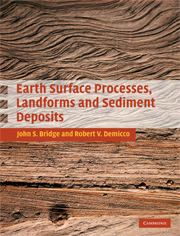Book contents
- Frontmatter
- Contents
- Acknowledgments
- Figure credits
- PART 1 Introduction
- PART 2 Production of sediment at the Earth's surface
- PART 3 Fundamentals of fluid flow, sediment transport, erosion, and deposition
- PART 4 Environments of erosion and deposition
- 13 Rivers, alluvial plains, and fans
- 14 Lakes
- 15 Coasts and shallow seas
- 16 Arid environments
- 17 Glacial and periglacial environments
- 18 Deep seas and oceans
- PART 5 Sediment into rock: diagenesis
- PART 6 Long-term, large-scale processes: mountains and sedimentary basins
- References
- Appendix: Methods of study of Earth surface processes, landforms, and sediments
- Index
- Plate section
16 - Arid environments
from PART 4 - Environments of erosion and deposition
Published online by Cambridge University Press: 05 June 2012
- Frontmatter
- Contents
- Acknowledgments
- Figure credits
- PART 1 Introduction
- PART 2 Production of sediment at the Earth's surface
- PART 3 Fundamentals of fluid flow, sediment transport, erosion, and deposition
- PART 4 Environments of erosion and deposition
- 13 Rivers, alluvial plains, and fans
- 14 Lakes
- 15 Coasts and shallow seas
- 16 Arid environments
- 17 Glacial and periglacial environments
- 18 Deep seas and oceans
- PART 5 Sediment into rock: diagenesis
- PART 6 Long-term, large-scale processes: mountains and sedimentary basins
- References
- Appendix: Methods of study of Earth surface processes, landforms, and sediments
- Index
- Plate section
Summary
Introduction
Arid and semi-arid environments occur over about a third of Earth's surface today. They are defined by a lack of precipitation relative to evaporation and evapotranspiration, and the resulting sparseness of vegetation. Arid environments are commonly referred to as deserts, although they are not actually deserted. They are a characteristic ecosystem in which organisms are adapted to their harsh environment. However, human activities are greatly curtailed in arid environments. Distinctive processes of weathering, erosion, and sediment transport involving water and wind (Chapter 6) result in distinctive landscapes, such as areas of bare rock molded into strange shapes by weathering and wind erosion, aeolian sand seas, and ephemeral rivers and lakes (playa lakes). Aeolian sand tends to have high porosity and permeability (depending on diagenesis), providing important aquifers and hydrocarbon reservoirs. Aeolian sand also tends to be quartz-rich and clay-free, which makes it useful for glass-making and sand pits for children. Aeolian silt (called loess) can be spread widely, and forms the basis of very fertile soil. Saline minerals are commonly deposited in closed continental lake basins and along coastlines in arid areas as water becomes progressively concentrated by evaporation (thus evaporite minerals: see Chapter 6). Cenozoic playa-lake deposits may contain valuable evaporite minerals such as trona and borate. Gypsum and halite comprise about 5% of the stratigraphic record and many of these salts accumulated in marginal-marine basins along desert coastlines throughout the Phanerozoic.
- Type
- Chapter
- Information
- Earth Surface Processes, Landforms and Sediment Deposits , pp. 563 - 594Publisher: Cambridge University PressPrint publication year: 2008



